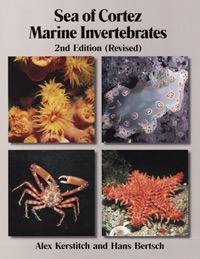Book Review: Sea of Cortez Marine Invertebrates, 2nd Edition

Marine life guides are the Rodney Dangerfields of underwater books. Nobody reads them cover to cover. Nobody proudly displays them on their coffee table. Instead of dramatic head-on or ¾ front views, the photographs inside are prosaic side views for identification purposes. Yet in the bookshelves of live-aboard boats, their dilapidated, dog-eared appearance attests to heavy use by the divers on board. For serious divers, they are an essential reference and an indispensable facet of our diving experience.
Marine biologist Hans Bertsch recently updated Alex Kerstitch’s classic Sea of Cortez Marine Invertebrates. Kerstitch died in 2001, and the original edition was over 15 years old. Critters don’t evolve much in that time, but knowledge does, and so does access and photography, so it was time for an update.
Dr. Bertsch is well qualified to write the new edition. He is a renowned expert on nudibranchs, and a prime contributor to Slugsite, the web’s leading site dedicated to opisthobranch mollusks. He’s listed as the second author despite having largely rewritten the book. But that’s traditional in publishing. The classic Between Pacific Tides still lists Ed Ricketts as primary author despite the fact he died in 1948, and the book, now in its 5th edition, has been revised by Jack Calvin, Joel Hedgpeth, and David Phillips.
Although the Sea of Cortez is the primary focus, Pacific coast divers will recognize many of the 300 species ranging from California through the Galapagos. The book follows the typical layout of Sea Challengers marine life guides, with three animals on each page featuring a color photo, the scientific and English names, a brief description, habitat and distribution, and a few interesting notes. The introduction includes a glossary, a general description of each phylum, and a strong conservation message.
For divers who frequent the Sea of Cortez and the Panamic region of the Pacific, and need to know the difference between aplysia and navinax, this latest edition is a valuable resource. The book is available direct from the author ( .(JavaScript must be enabled to view this email address) ) or from Amazon.com.